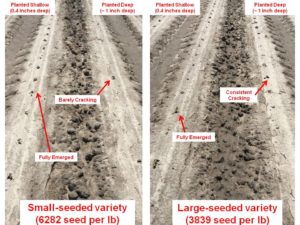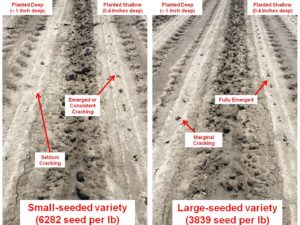Tips for Improving Cotton Stands During Periods of Marginal Planting Weather (Collins, Edmisten, & Reisig)
go.ncsu.edu/readext?463842
en Español / em Português
El inglés es el idioma de control de esta página. En la medida en que haya algún conflicto entre la traducción al inglés y la traducción, el inglés prevalece.
Al hacer clic en el enlace de traducción se activa un servicio de traducción gratuito para convertir la página al español. Al igual que con cualquier traducción por Internet, la conversión no es sensible al contexto y puede que no traduzca el texto en su significado original. NC State Extension no garantiza la exactitud del texto traducido. Por favor, tenga en cuenta que algunas aplicaciones y/o servicios pueden no funcionar como se espera cuando se traducen.
Português
Inglês é o idioma de controle desta página. Na medida que haja algum conflito entre o texto original em Inglês e a tradução, o Inglês prevalece.
Ao clicar no link de tradução, um serviço gratuito de tradução será ativado para converter a página para o Português. Como em qualquer tradução pela internet, a conversão não é sensivel ao contexto e pode não ocorrer a tradução para o significado orginal. O serviço de Extensão da Carolina do Norte (NC State Extension) não garante a exatidão do texto traduzido. Por favor, observe que algumas funções ou serviços podem não funcionar como esperado após a tradução.
English
English is the controlling language of this page. To the extent there is any conflict between the English text and the translation, English controls.
Clicking on the translation link activates a free translation service to convert the page to Spanish. As with any Internet translation, the conversion is not context-sensitive and may not translate the text to its original meaning. NC State Extension does not guarantee the accuracy of the translated text. Please note that some applications and/or services may not function as expected when translated.
Collapse ▲“Frustrating” is the best way to describe the recent planting conditions thus far. Significant rains confounded by cool weather has made the early part of our planting window less-than-ideal. Several growers put planting on hold since mid-week of last week, but we are approaching the time in which we must resume planting in order to get this crop in the ground before May 25th. This of course depends on how many acres you already have planted, and the number of acres you have left to plant. For growers that can plant the large majority of their cotton acres in short time-frame (a week or less), it is probably best to wait until next week to resume planting. For other growers that need to resume planting now (or very soon), there are a few things you can do to improve the chances of achieving optimal stands when planting in less-than-ideal conditions. As mentioned in Dr. Edmisten’s newsletter “Cotton Planting Conditions for May 8, 2017” released earlier today, these include:
1. Plant shallow (this is the primary purpose of this article). Cotton should generally be planted 0.5 to 0.7 inches deep. In periods of cool weather, we can maybe plant shallower than this (0.25 to 0.5 inches deep). Good soil/seed contact is essential, so plant as shallow as you can while still covering seed with soil. Planting deeper than 0.7 inches will prolong the time needed for seedlings to emerge which only serves as an added stress on seedlings that we do not need right now. Additionally, planting deep in marginal conditions could cause seed’s energy to expire before fully emerging, resulting in poor stands.
A trial investigating seed size and planting depth was planted at Rocky Mount on May 1st (exactly a week ago). This trial experienced decent temperatures for the first 2 to 3 days after planting, followed by a cold wet weekend with very low nighttime temperatures. Emergence was first noticed today. The photos below illustrate that both vigor and planting depth are important in achieving optimal stands, especially when less-than-ideal conditions occur. There was variation across the trial, therefore, scenarios for decent emergence and marginal emergence are both illustrated. In both cases, deep planting (approximately 1 inch) resulted in suboptimal emergence for both large and small-seeded varieties, however the larger-seeded variety was either emerged or cracking noticeably better than the small-seeded variety. This illustrates that smaller-seeded varieties may be more sensitive to deep planting, however planting shallow (approximately 0.4 inches deep) resulted in acceptable stands for both large and small-seeded varieties.

Figure 1. The effect of deep versus shallow planting for both large and small-seeded varieties where decent emergence occurred. (Click on photo to enlarge)

Figure 2. The effect of deep versus shallow planting for both large and small-seeded varieties where marginal emergence occurred. (Click on photo to enlarge)
2. Avoid using fertilizers in-furrow that could potentially damage germinating seed. Using starter fertilizers in a 2×2 placement is generally not a problem as long as rates and volume are within reason, and contact with seed is avoided.
3. Increase seeding rates 10 to 20 percent, depending on your current seeding rate. As a very general suggestion, if your current/normal seeding rate is rather low, consider increasing rates to 45,000 to 47,000 seed per acre.
4. Plant the largest seed you have with the best cool germ you have. Seed size (number of seed per lb) is either printed on the bag, or can be calculated by dividing the number of seed in a bag by the bag weight (lbs). The lower the number, the larger the seed. Cool germ percentages can be obtained by calling your dealer or seed company representative.
5. Consider using an in-furrow fungicide during cool periods, especially if you have a field history of seedling diseases. See Table 9-1. Point System for Determining the Need for In-Furrow Fungicides in the Cotton Information book “Disease Management in Cotton” chapter to help you determine whether or not a fungicide may be justified.
6. Be timely on foliar sprays for thrips. Slow emergence and early season growth can exacerbate thrips injury, and infurrow insecticides and seed treatments may expire before cotton reaches the 4-5-leaf “safe” stage. Thorough scouting and timeliness of foliar sprays (when the 1st true leaf first becomes visible/distinguishable between the cotyledons) is critical to minimize potential yield losses. Other host plants are or will be drying down soon, therefore thrips may likely move into cotton over the next couple of weeks.
The weather forecast changes frequently, and Dr. Edmisten does an excellent job of releasing timely Planting Conditions reports based on these forecasts. Stay tuned to the NC State Cotton website for these and other reports.


